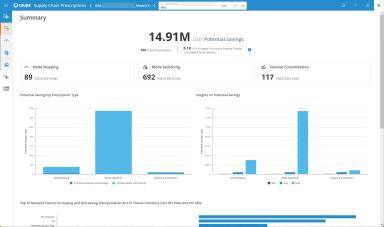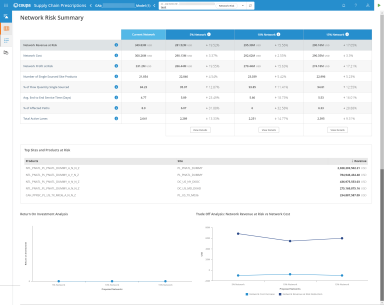Introduction to Supply Chain Prescriptions
Supply chains are complex. They can include millions of unique paths with a multitude of factors driving transportation and lane costs, such as number of touch points, choice of specific DCs, choice of modes, and more. Because of the staggering number of combinations, it can be difficult to determine the proper scenarios for driving cost savings. Without scenarios that scale across the entire breadth of the supply chain, modelers are precluded from providing ongoing implementable savings to their business.
In addition to the complexity of supply chains, they inherently involve risk. Recent years have highlighted that risk, as companies have struggled to overcome a variety of challenges to their supply chains. Single- and multi-point failures can lead to major disruptions of the supply chain, impacting corporate revenue and reputation. Modelers need to quantify and model risk in their supply chains as they work to make their supply chains more resilient and cost effective.
Supply Chain Prescriptions analyzes a supply chain’s data and provides descriptive, diagnostic, and prescriptive cost and risk insights based on that data. This data is made available through a Supply Chain model.
With the Supply Chain Prescriptions Cost app, you can generate the following transportation-based prescriptions that proactively identify potential savings in the supply chain:
-
Mode Switching
-
Node Skipping
-
Volume Consolidation
With the Supply Chain Prescriptions Network Risk app, you can mitigate the effects of potential single point failures that can lead to disruption of the supply chain network. The Network Risk app identifies sites and lanes that are critical from a revenue or value of goods flown perspective, and then generates constraints that must be imposed on the network to minimize the risk of critical sites and lanes. The constraints correspond to various levels of risk. There are four types of prescriptions for Network Risk:
-
Alternate supplier sites
-
Alternate manufacturer sites
-
Alternate distribution centers
-
Flow shifts
Both types of prescriptions can be reviewed by business users, who can accept or reject the prescriptions. This allows the Prescription engine to learn over time what prescriptions are feasible and what prescriptions are infeasible. When users reject prescriptions, the Supply Chain Prescriptions algorithm will use this information the next time it is run to improve the prescriptions it suggests.
Here are a few useful tips to get started:
- What's New provides information about the latest enhancements and features.
- Visit Getting started with Supply Chain Prescriptions to get an overview of the product features.
- Visit the Coupa Success Portal for additional information, including training, product releases and customer events.
Last modified: Friday May 12, 2023


